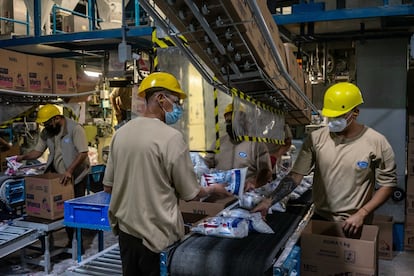Defying forecasts: Why is Mexico’s economy growing?
2023 is the third consecutive year in which the country’s economic growth has exceeded the projections of market analysts at the beginning of the year

After the global crisis unleashed by the Covid-19 pandemic, Mexico has sustained an annual economic growth of between 3% and 4%. The year 2023 marks the third consecutive year that Mexico’s economic growth has outpaced market analysts’ early-year forecasts. Looking ahead to 2024, the economic outlook remains cautiously positive.
This vigorous growth largely stems from a set of supply-side public policies launched at the onset of President López Obrador’s administration. These policies, including comprehensive labor reforms and strategic financial management, have cultivated an environment conducive to investment, resulting in a robust labor market and a marked increase in both public and private investments.
The fiscal strategy of the current administration has successfully kept the country’s debt-to-GDP ratio at a low level by international standards, enhancing Mexico’s appeal to global investors. Simultaneously, this administration has broken with the economic dogma that social spending and public investment are inversely related, managing to boost both while keeping debt levels stable.
In particular, labor reforms and a redesign of the social protection network have bolstered the incomes of Mexican families, contributing to a reduction in poverty and inequality and generally improving quality of life. These reforms have achieved the lowest average unemployment rate in the country’s history.
Economically, the combination of these government policies has significantly driven domestic consumption. Post the global Covid-19 crisis, Mexico’s internal market has contributed more to the country’s economic growth than during previous crises, which were more dependent on the external driver of exports often paired with currency devaluation. This time, however, the exchange rate has remained stable, exports have maintained their upward trend, and most critically, the domestic market has seen significant expansion.
By September 2023, investments in Mexico, both public and private, hit record highs, becoming primary engines of national economic growth. Public investment surged by 21.0% and private investment by 19.7% compared to the same period last year. This surge is a testament to infrastructure projects that have enhanced connectivity, trade facilitation, and mass mobility, substantially boosting the country’s productive capacity.
Contrary to early predictions of investment decline, Mexico has demonstrated robust business confidence and a central role in the global reshaping of production chains. These developments highlight the country’s economic resilience and positive dynamic.
The upcoming year is anticipated to be favorable for investment, thanks to a more accommodating financial environment. The quick alignment of inflation with targets and the lowering of interest rates in Mexico, currently at historic highs, signal a conducive economic climate. This setting, marked by stability and potential new investment prospects, is expected to sustain Mexico’s growth and developmental trajectory.
Infrastructure initiatives such as the Mayan Train, Felipe Ángeles Airport, Tulum Airport, and the Interoceanic Corridor are significant not only for improving connectivity and mobility but also for addressing socioeconomic disparities between Mexico’s northern and southern regions. Targeted investments in the south-southeast have significantly uplifted living standards, with these regions growing at twice the national average, signaling the administration’s commitment to balanced economic development.
In terms of international trade, foreign direct investment (FDI) in Mexico remains steady and on the rise. Fiscal and macroeconomic stability, coupled with an intensified focus on international trade, position Mexico as an attractive investment destination. As of November, announced investments exceed $100 billion, with expectations for this figure to climb in the coming year.
In 2023, Mexico consolidated its role as the United States’ chief trade partner, outpacing historically dominant nations. The nearshoring has renewed interest in investing in Mexico, stimulating employment and industrial activity both domestically and in the U.S., where manufacturing plant construction has seen real-term growth of over 50%.
Mexico’s growth above its historical average is the result of combined policy and reform effects, not mere chance or luck. The economic prospects for 2024 are promising, with growth expected to range between 2.5% and 3.5%. The forthcoming year is set to be a period of positive transition, based on robust investment, strong consumer spending, and a healthy job market, alongside continued policies aimed at reducing social and economic disparities.
Sign up for our weekly newsletter to get more English-language news coverage from EL PAÍS USA Edition
Tu suscripción se está usando en otro dispositivo
¿Quieres añadir otro usuario a tu suscripción?
Si continúas leyendo en este dispositivo, no se podrá leer en el otro.
FlechaTu suscripción se está usando en otro dispositivo y solo puedes acceder a EL PAÍS desde un dispositivo a la vez.
Si quieres compartir tu cuenta, cambia tu suscripción a la modalidad Premium, así podrás añadir otro usuario. Cada uno accederá con su propia cuenta de email, lo que os permitirá personalizar vuestra experiencia en EL PAÍS.
¿Tienes una suscripción de empresa? Accede aquí para contratar más cuentas.
En el caso de no saber quién está usando tu cuenta, te recomendamos cambiar tu contraseña aquí.
Si decides continuar compartiendo tu cuenta, este mensaje se mostrará en tu dispositivo y en el de la otra persona que está usando tu cuenta de forma indefinida, afectando a tu experiencia de lectura. Puedes consultar aquí los términos y condiciones de la suscripción digital.
More information
Archived In
Últimas noticias
Most viewed
- Reinhard Genzel, Nobel laureate in physics: ‘One-minute videos will never give you the truth’
- Oona Chaplin: ‘I told James Cameron that I was living in a treehouse and starting a permaculture project with a friend’
- Pablo Escobar’s hippos: A serious environmental problem, 40 years on
- Why we lost the habit of sleeping in two segments and how that changed our sense of time
- Charles Dubouloz, mountaineering star, retires at 36 with a farewell tour inspired by Walter Bonatti










































